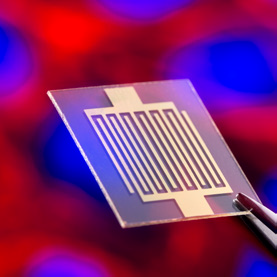Tissue models with integrated sensor technology using the modular principle

As part of the TissueSense project, Fraunhofer EMFT is optimizing 3D tissue models for pharmacological research by integrating sensors.
Laboratory-grown tissue is increasingly being used in drug development and in the assessment of biological, chemical, or physical hazards. These models are used to test the reaction of the cells to various external stimuli. However, two-dimensional cell layers only reflect reality to a limited extent, whereas three-dimensional models can only be quantitatively investigated by subsequent degradation of the material. With the TissueSense concept, tailor-made 3D tissue models can be created using the modular principle: First, 2D cell monolayers are cultivated individually on thin porous polymer substrates and then assembled in such a way that they interact with each other and exchange substances like a natural organism. Signal converters integrated into the polymer substrates allow non-invasive and real-time measurement of the chemical and physical parameters of each individual cell layer of the 3D tissue model. This enables an unprecedented depth of information, especially in the screening of substance libraries.
Last modified: